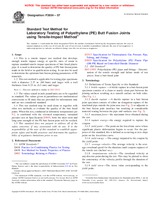Wir benötigen Ihre Einwilligung zur Verwendung der einzelnen Daten, damit Sie unter anderem Informationen zu Ihren Interessen einsehen können. Klicken Sie auf "OK", um Ihre Zustimmung zu erteilen.
ASTM F2634-07
Standard Test Method for Laboratory Testing of Polyethylene (PE) Butt Fusion Joints using Tensile-Impact Method
Automatische name übersetzung:
Standard Test Method for Laboratory Testing von Polyethylen (PE) Stumpfschweißverbindungmit Zug -Impact -Methode
NORM herausgegeben am 1.3.2007
Informationen über die Norm:
Bezeichnung normen: ASTM F2634-07
Anmerkung: UNGÜLTIG
Ausgabedatum normen: 1.3.2007
SKU: NS-54280
Zahl der Seiten: 9
Gewicht ca.: 27 g (0.06 Pfund)
Land: Amerikanische technische Norm
Kategorie: Technische Normen ASTM
Die Annotation des Normtextes ASTM F2634-07 :
Keywords:
butt fusion, butt fusion joint test, tensile-impact, rupture energy, yield energy, ICS Number Code 23.040.45 (Plastic fittings)
Ergänzende Informationen
| Significance and Use | ||||||||||||
|
This test method is designed to impart tensile impact energy to a butt fused plastic pipe specimen, record the energy to fail the specimen and plot the load over time curve of the tensile test. Energy recorded at yield and rupture and the rupture mode (brittle or ductile) are used as criteria in the evaluation of the butt fusion joint. The evaluation of the force/time curve not only makes it possible to compare different butt fusion parameters but also to evaluate the rupture mode of the specimen to determine joint integrity. Each coupon’test results will usually be compared to test results for coupons machined from the base pipe material, un-fused. 4.1.1 These data are also useful for qualitative characterization and for research and development. For many materials, there may be a specification that requires the use of this test method, but with some procedural modifications that take precedence when adhering to the specification. Therefore, it is advisable to refer to that material specification before using this test method. Tensile properties may vary with specimen preparation and with speed and environment of testing. Consequently, where precise comparative results are desired, these factors must be carefully controlled. 4.2.1 It is realized that a material cannot be tested without also testing the method of preparation of that material. Hence, when comparative tests of materials per se are desired, the greatest care must be exercised to ensure that all specimens are prepared in exactly the same way, unless the test is to include the effects of specimen preparation. While care must be taken to secure the maximum degree of uniformity in details of preparation, treatment, and handling, the exact dimensions of the test specimens are entered into the Data Acquisition System (DAS) before initiating the test. |
||||||||||||
| 1. Scope | ||||||||||||
|
1.1 This is a tensile impact test method that develops enough tensile impact energy at specific rates of strain to rupture standard tensile impact specimens of butt fused plastic pipe. It is used to determine the quality of PE butt fusion joints made in the field or in qualification testing. It can also be used to determine the optimum butt fusion joining parameters of PE materials. 1.2 This test method is applicable for testing pipe specimens with a diameter 2.37 in. (60.3mm) and larger with a wall thickness from 0.25 in. (6.3 mm) and larger. Note 1—This test method is similar to ISO 13953. 1.3 The values stated in inch-pound units are to be regarded as standard. The values given in parentheses are mathematical conversions to SI units that are provided for information only and are not considered standard. 1.4 This test method may be used alone or together with other test methods, to evaluate the quality of the butt fused joints. When this test, conducted at laboratory temperatures per 9.2, is combined with the elevated temperature, sustained pressure test in Specification D 3035, both the short term and long term strength of the PE butt fusion joint will be verified. 1.5 This standard does not purport to address all of the safety concerns, if any, associated with its use. It is the responsibility of the user of this standard to establish appropriate safety and health practices and determine the applicability of regulatory limitations prior to use. |
||||||||||||
| 2. Referenced Documents | ||||||||||||
|
Empfehlungen:
Aktualisierung der technischen Normen
Wollen Sie sich sicher sein, dass Sie nur die gültigen technischen Normen verwenden?
Wir bieten Ihnen eine Lösung, die Ihnen eine Monatsübersicht über die Aktualität der von Ihnen angewandten Normen sicher stellt.
Brauchen Sie mehr Informationen? Sehen Sie sich diese Seite an.




 Cookies
Cookies
